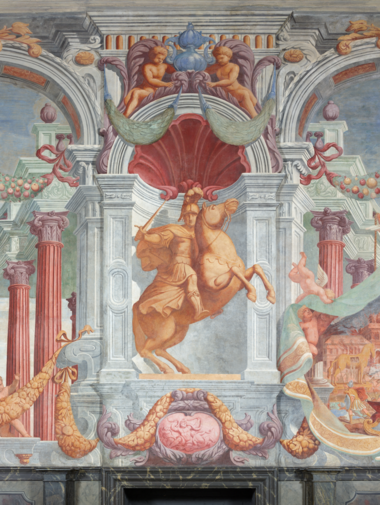The Significance of Ceiling Painting
Transforming Spaces through Ceiling Painting
Representative interiors in Early Modern Europe exhibit a captivating fusion of architecture and diverse forms of pictorial art, creating complex and unified spaces. Mural paintings on walls and ceilings have the power to dramatically alter the perception and significance of a given area, both in terms of form and theme. Ceilings, framed by stucco, stone, or wood, and complemented by secondary figural scenes, personifications, or emblems in cartouches, lunettes, or wall panels, convey historical functions and profound meaning from their elevated position.
Quadri Riportati and Finestra Aperta
Illusions and Perspectives Wall and ceiling decorations can take different forms, such as paintings directly applied to plaster, frescoes or secco techniques, or even framed canvases. Murals may allude to the practice of quadri riportati, creating the illusion of high-mounted framed images. Additionally, ceiling paintings may feature meticulously painted architectural frames that seemingly open up to reveal a view of the sky or imagined space, employing the principle of the finestra aperta.
Ceiling Painting: The Essence of a Space
Figural and illusionistic paintings on walls and ceilings exhibit intricate visual programs with hierarchical and narrative iconographic structures. Their purpose is to engage with the viewer, as articulated by Gérard de Lairesse's contemporary art theory, which regarded ceiling paintings as the soul of a room. Addressing a wide range of themes, from pagan gods and Christian saints to emblems, signs, and symbols, these paintings convey messages rooted in cosmology, mythology, ancient history, the history of salvation, as well as ethics and politics.
Introducing Baroque Ceiling Painting: A Short Bibliography
Decoding Baroque Ceiling Painting

The Corpus of Baroque Ceiling Painting in Germany (CbDD) aims to unravel the intricate visual codes embedded in mural painting within the context of their architectural frames and representative functions. This project undertakes the documentation, analysis, and interpretation of mural paintings, considering their iconographic, historical, sociological, art historical, and literary contexts. The primary focus lies on the programmatic and iconological aspects of this innovative visual medium, exploring the development, refinement, and complex iconography it encompasses.
Historical Context: Early Modern Europe and the Holy Roman Empire
The term Baroque understood as a historical period rather than a style, is a reference to the preceding Corpus project published in print form. The new research scheme will broaden the timeframe from the Renaissance to Classicism, from around 1550 to 1800: the Early Modern Period is the setting. For sheer pragmatic reasons, the project will remain focussed on monuments within the Federal Republic of Germany. International cooperations, interdisciplinary networks, conferences, and workshops across borders, territories, and disciplines will put the objects back into their historical context: The Holy Roman Empire before 1806.
Interdisciplinary Approach
The Corpus of Baroque Ceiling Painting in Germany (CbDD) aims to make all available documentation about the objects, their complex history, and iconographic contents easily accessible for further research across various disciplines in the arts and humanities. Through systematic appraisal and documentation of artworks, sources, and archival materials, this project establishes the foundation for rediscovering and analyzing the historical context, thematic correlations of the programs, and conceptual relationships between the objects.
Mural Painting: Preservation, Restoration, Destruction and Reconstruction

The Corpus of Baroque Ceiling Painting in Germany (CbDD) will encompass both preserved and restored monuments, recognizing the delicate nature of ceiling murals and the need for frequent restoration efforts. Additionally, the Corpus will include objects that were tragically destroyed during World War II, such as the ceiling paintings in the former Residential Palace in Berlin or the former château at Herrenhausen, Hannover. These lost objects can now only be studied through the historical photographic documentation preserved in archives.
Preserving History: The Farbdiaarchiv and Digital Acces
The Deutsche Dokumentationszentrum für Kunstgeschichte ̶ Bildarchiv Foto Marburg houses a significant collection of historical photography, including the invaluable "Farbdiaarchiv der Wand- und Deckenmalerei 1943 – 1945." This documentary campaign, known as the "Führerauftrag Monumentalmalerei," was initiated by the Ministry of Culture in Berlin towards the end of the Second World War. It employed the expensive medium of color slide film to capture buildings and paintings, often just days before their destruction.
Recognizing the importance of this archive, the Deutsches Dokumentationszentrum für Kunstgeschichte – Bildarchiv Foto Marburg, in collaboration with the Zentralinstitut für Kunstgeschichte in Munich, embarked on a digitization project to preserve and make these slides accessible to the public. The slides were transformed into digital format and are now available in an open-access database hosted by the Bildindex der Kunst und Architektur, Bildarchiv Foto Marburg, as well as the Zentralinstitut für Kunstgeschichte München, Farbdiaarchiv – Mitteleuropäische Wand- und Deckenmalerei, Stuckdekorationen und Raumausstattungen. This digital archive allows researchers and the public to explore and study these historical documents, providing valuable insights into the art and architecture of that era.
Data Processing via Digital Technology and Semantic Web
The new Corpus of Baroque Ceiling Painting in Germany (CbDD) is committed to providing public access to all research findings through an internet platform, following the principles of Open Access and embracing a continuous publication process. The project remains responsive to evolving standards and embraces the ongoing developments within the Semantic Web. The dedicated online publication database, tailored to the specific requirements of this image-focused research endeavor, will be hosted at the Deutsche Dokumentationszentrum für Kunstgeschichte – Bildarchiv Foto Marburg.
Fusion of Art History and Digital Humanities
Through the comprehensive overview and accessible online publication, Baroque ceiling painting will be made available to researchers, the general public, and an international audience. Given its significance as a specific form of pictorial art deeply intertwined with architecture, the mural painting of the Early Modern period deserves special attention and holds transnational and interdisciplinary appeal. The database, equipped with links to additional research tools, provides readers with unique opportunities that traditional book publications cannot offer. Leveraging the potential of digital photography and multimedia visualizations, the documentation relies on cutting-edge technologies and embraces the transformative possibilities of digital humanities for enriching art historical research on the Baroque.
